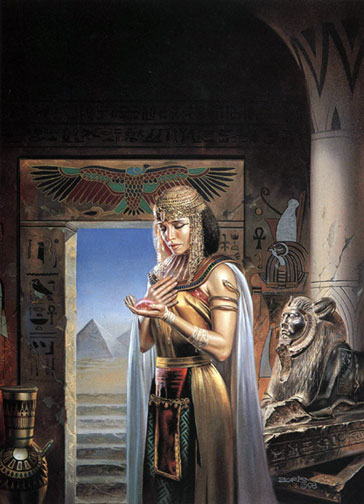
By Jennifer Viegas, Discovery News
Egyptian Princess, painting by Boris Vallejo 1998
If historians can verify the medieval accounts, then the real Cleopatra likely bore little resemblance to the sexy seductress described by Greek and Roman scholars.
The book, "Egyptology: The Missing Millennium, Ancient Egypt in Medieval Arabic Writings," will be published in January by the University College London Press. For the book, author Okasha El Daly, an Egyptologist at the Petrie Museum of Egyptian Archaeology at University College London, found previously undiscovered medieval Arabic texts, translated them, and analyzed the texts based on his knowledge of early Egyptian history.
El Daly believes the Arab writers had access to first-hand accounts of Cleopatra, and perhaps even books authored by the famous queen herself. He thinks many of these texts no longer exist.
A library at Alexandria was said to have been burned in ancient times, possibly by a Muslim general who wished to destroy texts written before the Koran, according to Lisa Schwappach, curator of the Rosicrucian Egyptian Museum in California.
El Daly attributes the first Arab account of Cleopatra as a scientist to Al-Masudi, who died in 956 A.D. In his book "Muruj," Al-Masudi wrote of Cleopatra, "She was a sage, a philosopher who elevated the ranks of scholars and enjoyed their company. She also wrote books on medicine, charms and cosmetics, in addition to many other books ascribed to her which are known to those who practice medicine."
Medieval Arab writers such as Al-Bakri, Yaqut, Ibn Al-Ibri, Ibn Duqmaq and Al-Maqrizi also wrote how impressed they were by the queen's building projects. In fact, El Daly believes the earliest Arabic book to mention Cleopatra, a history of Egypt by the Egyptian bishop John of Nikiou, says the queen's building projects in Alexandria were "the like of which had never been seen before."
Yet another Arab historian, Ibn Ab Al-Hakam, credits one of the greatest structures of the ancient world, the Lighthouse of Alexandria, to Cleopatra.
In an interview with Radio Netherlands, El Daly said, "It was not just a lighthouse to guide ships, it was a magnificent telescope and it had a huge lens that could burn the oncoming ships of enemies that were going to attack Egypt."
Other early Arabic sources say Cleopatra created a recipe for a hair loss treatment and even studied gynecology. Writers Ibn Fatik and Ibn Usaybiah indicate that she conducted experiments to determine development stages of the human fetus in the womb.
"Above all, Cleopatra was an alchemist," El Daly told Discovery News. "She invented a tool to analyze liquids. Also, she was not working in a vacuum. There is ample evidence that many women in ancient Egypt served as doctors and were educated in the sciences."
He added, "All of our current knowledge about Cleopatra comes from enemy sources. The Romans were scornful of her and wanted to portray her as this little sexy thing."
El Daly pointed out that coins depicted her as actually being a very plain woman who was not a beauty "in any conventional sense."
Mary Lefkowitz, Andrew W. Mellon professor in the Humanities at the Department of Classical Studies at Wellesley College, disagreed that Romans negatively described Cleopatra.
"Actually, the Romans admired Cleopatra, although they were afraid of her power while it lasted," Lefkowitz told Discovery News.
Lefkowitz added that Cleopatra was a royal name in the Ptolemaic dynasty of Egypt, so the Arabic texts could have been referring to more than one queen with the same name.
Schwappach, however, believes it is possible that the most famous Cleopatra, Cleopatra VII, was more of a scientist than a seductress.
"That Cleopatra was at least concerned with medicine is evident from her support of the Temple of Hathor at Dendera," Schwappach told Discovery News. "Women, in particular, came to this temple for healing, both physical and mental."
She added, "Cleopatra was educated in the sciences, and no doubt encouraged scientists and discussed their findings and thoughts with them. She would have been an equal among them, not because of her social standing, but because of her intelligence and education."
Source: http://www.womanthouartgod.com/artseductress.php


















1 comments:
Smart post and so good blog
thanks for you good information and i hope to subscribe and visit my blog Ancient Egyptian Jewelry and more Ancient Egypt History thanks again admin
Post a Comment